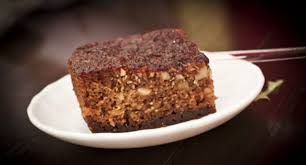Aasmi
Aasmi is a traditional Sri Lankan sweet delicacy, often
served during special occasions such as Sinhala and Tamil New Year, weddings,
or special occasions. It is known for its crunchy texture and unique flavor,
which comes from a blend of rice flour and coconut milk with cinnamon or
cardamom. That sweet taste is very soft.
Helapa
Helapa is a beloved part of traditional Sri Lankan village
cuisine. It is nutritious, natural, and often enjoyed as a healthy snack or
breakfast item. The use of kurakkan makes it rich in fiber and iron, which is
especially valued in rural diets. This helapa is made by mixing Kurrakan powder
and treacle. It steamed with Kanda leaves. Which gives it a distinct flavor.
Aluwa
This is a traditional Sri Lankan dessert. Generally it is used
during tea time. It is made with toasted rice flour, sugar syrup, ground cashew
nuts, cardamom, and cashews. The mixture is spread into pans and is then
sliced, usually into diamond-shaped pieces. Aluwa is a staple dessert served on
Avurudu—the Sinhalese New Year celebrated in April.
Athirasa
Athirasa is a traditional Sri Lankan sweet treat. This sweet is
specially used during Sinhala and Tamil New Year, weddings, and other cultural
celebrations. It’s a deep-fried, sweet rice cake made with rice flour and
jaggery, offering a rich, chewy texture with a caramel flavor. This sweet is
offering older Ceylon people's food style.
Bibikkan
Bibikkan is a rich, spiced coconut cake that is a beloved
traditional Sri Lankan dessert. This food item is especially enjoyed during
Christmas, New Year, and special occasions. It is made with grated coconut, kithul jaggery,
spices, cashews, butter, and vanilla. Unlike light Western cakes, bibikkan is hearty,
rustic, and very filling, often enjoyed in small portions with
tea.
Kokis
Kokis is another Sri Lankan traditional food item. Its batter is
made with coconut milk, eggs, and rice flour. The batter is coated around
decorative molds and deep-fried in coconut oil until it develops a crispy
texture. Sometimes spices mix with this batter. Kokis can be consumed as an
appetizer, snack, or dessert, and it is a compulsory food item around Sinhala
and Tamil New Year celebrations.












No comments:
Post a Comment